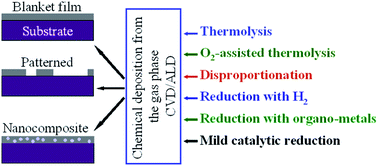Metal thin films are indispensable for the processing of a number of modern devices that benefit from their electronic, magneto-electric and optical properties. Application trends progressively involve integration into functional devices which feature three-dimensional nanostructures with increasingly high aspect ratios. These conditions promote increased interest towards non-line-of-sight deposition processes such as Chemical Vapour Deposition (CVD) and Atomic Layer Deposition (ALD). The deposition of metals using CVD or ALD is, however, less developed than that of the oxide counterparts. Several persisting limitations are directly related to the deposition chemistry. In the present perspective, relevant deposition chemical approaches are discussed along with their corresponding characteristics. Challenging issues regarding the purity and the nucleation kinetics are addressed. Using the intrinsic reactivity of the metals themselves to catalyse their own growth is one of the promising approaches emphasised here. Based on our recent work, the potential of this approach is discussed with respect to the growth of reactive and noble transition metals, pure or as alloys, as thin films or as embedded nanoparticles in functional oxide matrix thin films.

You have access to this article
 Please wait while we load your content...
Something went wrong. Try again?
Please wait while we load your content...
Something went wrong. Try again?


 Please wait while we load your content...
Please wait while we load your content...